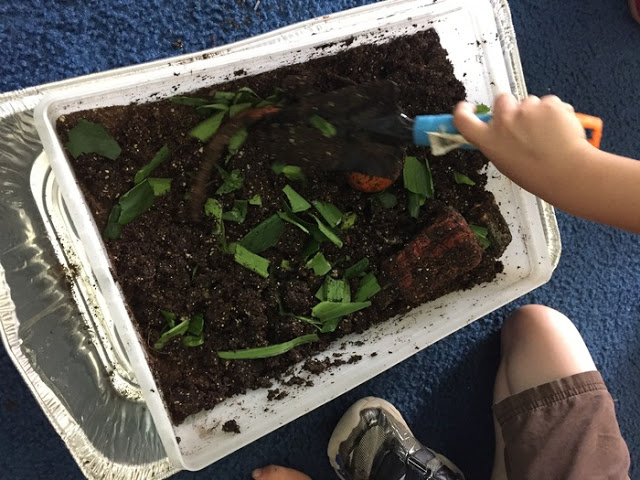I challenged the children to predict which pumpkin would decompose the fastest (pumpkin 1 or 2)?
Then, they forgot about them – for a loooong time! And there they sat, until one day in April! Somebody noticed how much the one pumpkin had changed and suddenly all the children were gathered around. Their interest was renewed!
It didn’t take long for the children to notice changes.
I placed it in some water and the all-day sucker dissolved in a matter of minutes! I let them use the stick to explore the liquid that was left and they were surprised by the muddy brown color of the water. One child explained that this is what happens when you mix all of the colors together.
At this point in the project, a worm showed up! I was leaving my mother’s house one rainy Sunday and there he was on the driveway. His timing was right on cue, as we were studying soil as part of a Plant Project, while also exploring decomposition. He fit in perfectly!
So I brought him into the classroom and the children spent time doing worm observations and recording what they saw, thought, and wondered.
We also did a little research and wrote a nonfiction All About Worms Book about him.
So we began with some of our remaining planting soil, took turns adding in food and water and mixing it all up. We even added the leaves from a flower bulb we had grown in the winter and the soil from seed pots that never sprouted.
On one of our last days of school, we headed outdoors to place the remaining food near the woods for the animals we knew lived there. This class has seen deer, but in past years there has been turkey, fox, and coyote sightings.
Thanks for stopping by!
































 Making a Plan for the Covid Friendly Classroom
Making a Plan for the Covid Friendly Classroom Growing Our Thinking Around Matter
Growing Our Thinking Around Matter Halloween Tap and Write Reader Freebie
Halloween Tap and Write Reader Freebie Moving From Themes to Project Based Learning in Kindergarten
Moving From Themes to Project Based Learning in Kindergarten